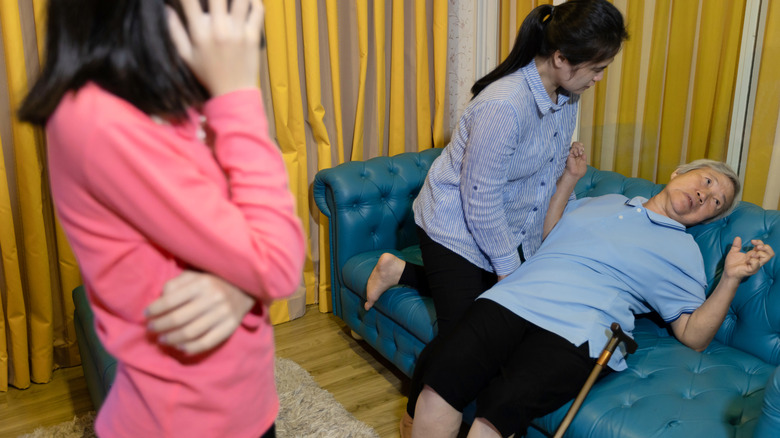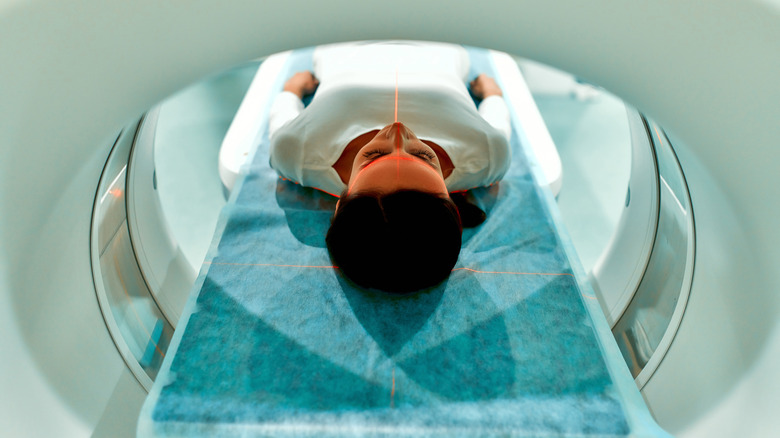Signs Of Seizures At Every Age
Approximately 11% of people in the U.S. have at least one seizure in their lifetime (via the Cleveland Clinic). A seizure occurs when neurons — brain cells — malfunction and cause atypical and uncontrolled electrical activity in the brain. As a result, you are not able to control parts of your body that you normally can.
How seizures look can differ from person to person. However, someone who experiences them will usually show the same behaviors from one seizure episode to the next (per Epilepsy Foundation). Having or witnessing a seizure can be very scary. However, according to the Centers for Disease Control and Prevention (CDC), most seizures do not require emergency medical services unless the person has breathing problems, gets injured, or the episode lasts five minutes or longer. If you see someone having a seizure, you should stay with the person and try to gently help them to lie on their side on the floor so they don't injure themselves. You should not restrain them, nor put anything in their mouth. Try to track and record as much as you can about the seizure and its duration. This can help during a consultation afterward with a medical provider. Signs and causes of seizures can vary depending on age group and the type of seizure. Knowing the signs can help you to identify and appropriately respond when you see someone having one.
Partial seizures
Partial seizures — also known as focal seizures — begin in one part of the brain and then spread (via Johns Hopkins Medicine). More symptoms manifest as the seizure spreads, and they can range in severity depending on the size of the spread. If the seizure involves a large portion of the brain, the person may feel confused or experience shaking or muscle stiffening. If the focal seizure remains in a specific area of the brain, the person is often aware of what is happening. If the partial seizure then spreads to the entire brain, it can cause more serious consequences such as breathing problems and injuries.
Healthline explains that there are "simple" partial seizures and "complex" partial seizures. Simple partial seizures tend to have a duration of no more than one minute. And even though you do not lose consciousness during a simple partial seizure, many people do not recall later what happened during the episode. You can become unconscious during a complex partial seizure and it can last for a couple minutes. Some people may experience minor symptoms that are sort of like warnings that a complex focal seizure is about to happen, including feeling nauseous or uneasy. Like with simple partial seizures, people tend to not recall what happened during complex partial seizures.
Generalized seizures
A generalized seizure means that a few abnormal electrical firings happen throughout the brain at the same time. There are four main types of generalized seizures: absence, myoclonic, tonic/atonic, and tonic-clonic (via Johns Hopkins Medicine). Absence seizures, also known as "petit mal" seizures, are characterized by a short break in consciousness (per Cleveland Clinic). They usually start without warning but the person recovers right away. Myoclonic seizures are abrupt, brief, and uncontrollable jerks of body parts while the person is fully aware of what is happening (via Cleveland Clinic). These seizures also tend to happen in clusters, or groups of muscles like your arms, legs, or face.
Tonic seizures involve muscle tension that comes on quickly. Atonic seizures are the opposite — they may cause someone to go limp. Both tonic and atonic seizures can cause falls and injuries, which is why they are also known as "drop attacks." A tonic-atonic seizure is characterized by a tonic episode immediately followed by an atonic episode (via Johns Hopkins Medicine).
And lastly, tonic-clonic seizures — which used to be called Grand Mal seizures — are intense and occur in two phases. The tonic phase involves loss of consciousness and strong muscle spasms – as a result the person might fall to the floor. It might also include foaming at the mouth, a blue or ashen face, difficulty breathing, and sounds of gurgling or panting. In the clonic phase, parts of the body jerk with greater speed and intensity before relaxing again after a couple minutes. As the jerking slows down, the person can lose control of their bladder or bowels (per Johns Hopkins Medicine).
Signs of neonatal seizures
The neonatal period is the first 28 days of life (per UCSF Benioff Children's Hospitals). Surprisingly, this is the period of life in which someone is most likely to have seizures (via National Library of Medicine). Premature newborns or those with low birth weight are more likely to experience them (via UCSF Benioff Children's Hospitals). Most seizures among newborns are harder to distinguish from normal behavior (per National Library of Medicine). Signs include suddenly crying or being aroused, moving their mouth like they are sucking or chewing, flickering their eyelids, staring, roaming their eyes or gazing upward, making swimming or pedaling movements with their limbs, and pausing their breathing. Other symptoms include turning their head or eyes to one side, sticking out their tongue, and twitching or making rigid the muscles in the face, tongue, limbs, or other parts of the body.
Quivering or jitteriness is different from seizures. It is common in the neonatal period and is not harmful (via Queensland Health). It can happen when the baby is sleeping, awake, or crying. However, jitters stop when you hold the moving body part or pick up the baby, whereas seizures do not.
There can be various causes for neonatal seizures with some occurring in the brain, including bleeding, blood clots, and birth defects (per UCSF Benioff Children's Hospitals). Another is lack of oxygen to the baby from events such as strenuous labor or squeezing of the umbilical cord. Some neonatal seizures are mild, but those that are more severe can cause serious damage. Rapid diagnosis and care by the newborn's healthcare team are essential.
Signs of seizures in babies and toddlers
According to the University of Chicago Medicine, about .1% babies have seizures. Focal seizures are more common among infants, while generalized seizures are rare. Some signs include moving arms and legs that cannot be stopped, an abrupt halt in motion with eyes looking to one side, muscles suddenly going rigid, and extended or flexed forearms. Spasms may also occur in 5- to 10-second episodes over a period of several minutes when the baby is going to sleep or right after awakening. Queensland Health states that babies repeatedly twitch their limbs while they are asleep — this is not a seizure, and it stops when the baby wakes up. Happiest Baby also notes that twitching of eyelids or cheeks can happen during sleep and it is not worrisome.
A febrile seizure is one that usually happens when a baby or toddler has a fever above 101 degrees. Febrile seizures tend to begin at 6 months old, and each episode lasts for about a few minutes (per University Hospitals). A "simple" febrile seizure lasts less than 15 minutes and occurs once in 24 hours. "Complex" febrile seizures last longer and happen more frequently. Symptoms include uncontrollable shaking and possible loss of consciousness. Generally, there are no lasting health or learning problems as a result of febrile seizures.
Signs of seizures in children
Some seizures in children are so mild you might not even recognize them as seizures (via Boston Children's Hospital). For instance, it can be a brief moment of very strong emotions. Epileptic absence seizures typically develop between the ages of four and six (via Johns Hopkins Medicine). These manifest as brief staring episodes, which can look like the child is daydreaming (per Cleveland Clinic). Children usually outgrow absence seizures in their teens.
Other symptoms are more obvious signs that a child is having a seizure, like having convulsions or becoming unconscious (per Boston Children's Hospital). Additional signs include trouble breathing, body going rigid, loss of bowel or bladder control, falling for no reason, looking confused, extreme sleepiness, irritability upon waking, vomiting, and continual head nodding. Sometimes seizures are associated with long-term neurological conditions, or problems with learning and behavior (via Boston Children's Hospital). Partial seizures in children – which may be associated with a change in consciousness – could show up as gagging, smacking of lips, running, screaming, crying, or laughing. The child may feel tired after a partial seizure (per Boston Children's Hospital).
Signs of seizures in teenagers
According to a review published in Archives of Disease in Childhood, among neurological disorders that tend to begin in adolescence, idiopathic — or genetic — epilepsy is the most common, and can present as one of several different syndromes. One is juvenile myoclonic epilepsy, which can include myoclonic or tonic-clonic seizures. Among teenagers, tonic-clonic ones happen most often. They tend to begin in puberty and oftentimes occur from lack of sleep and within two hours of awakening. They can also occur if a teenager has been playing video games in darkness.
Another type of epilepsy — juvenile absence epilepsy – usually presents between the ages of 10 and 13. The absence seizures tend to occur daily and can last for over a minute. The sign of an absence seizure is a lapse in consciousness, but the teen might still have some ability to speak. Those with this condition may continue to have seizures throughout their life, but they do happen less frequently over time.
Isolated partial seizures are rare among adolescents — these involve jerking of a section of the body during sleep or upon waking. Late-onset childhood occipital epilepsy is also rare, but can occur up to 16 years of age. Seizures in this case involve the brain's occipital lobe and thus can result in temporary unconsciousness, hallucinations, or blindness. Approximately half of teens who have these seizures experience headache, nausea, and vomiting after the episode. If you start to notice more frequent seizures in your teen, it might be because they have stopped taking their medication — it is important to talk with them about the necessity of medication, and avoiding drugs and alcohol (per WebMD).
Signs of seizures in younger adults
According to Healthline, seizures that begin in adulthood are usually caused by head trauma or a medical condition like stroke, infection of the central nervous system (CNS), or substance misuse and withdrawal. However, in one study in the Journal of Family Medicine and Primary Care, genetics was the most common cause of seizures in adults younger than 20 years of age, and genetics and CNS infection were the common causes of seizures in adults younger than 40 years of age. Genetic epilepsy that begins in adulthood is fairly frequent but innocuous — the seizures are usually provoked and therefore can be managed by avoiding their triggers.
A stroke occurs when a blockage prevents blood flow to the brain. Without oxygen and nutrients from the blood, brain cells die (via National Heart, Lung, and Blood Institute). In effect, a part of the brain becomes injured. Subsequently, scar tissue forms that impacts the electrical activity in the brain, causing a seizure (via Healthline). The first 30 days after a stroke is when there is the highest chance of having a seizure. A seizure can also occur within 24 hours after a stroke if it is severe. In the cases of stroke, generalized seizures are most common and can include convulsions, unconsciousness, tingling sensations, and muscle spasms. Other possible seizure symptoms include confusion, altered senses, emotional changes, and bladder incontinence.
Gelastic and dacrystic seizures are other types of generalized seizures that happens in adults (per Healthline). Gelastic seizures cause out-of-control laughing, and dacrystic seizures cause crying, and both are linked to a specific kind of brain lesion, a hypothalamic hamartoma.
Signs of seizures in middle-aged and older adults
Over the course of the lifespan, the number of generalized seizures lowers and focal seizures become more common. And among middle-aged and older adults, in particular, an increase in focal seizures is linked to stroke, which is common in this population, according to a study in the Journal of Family Medicine and Primary Care.
The Epilepsy Foundation reports that types of seizures among adults in their 60s and older include generalized tonic-clonic and partial seizures. "Simple" partial seizures are electrical disturbances in the part of the brain that controls the senses. These can lead to emotional changes, changes in sensory perception, or shaking. The person remains completely conscious during such an episode.
On the other hand, though they can happen at any age, "complex" partial seizures are more frequent in older individuals. A person having a complex partial seizure can look confused, stare, mumble, make chewing movements, pick at their clothing, and perform actions repetitively. The person won't be able to talk to others during the seizure, but may be able to respond to a request. In rare cases, the person may become agitated, wander, try to undress themselves, scream, try to run, or recoil from fear (per the Epilepsy Foundation).
Signs of end-of-life seizures
As reported by a review in Neuro-Oncology Practice, scientific knowledge is limited on seizures during the end-of-life (EOL) phase. According to Marie Curie, it is possible for some individuals to have a seizure for the first time in the last few weeks of their life. However, it is more common among those with a history of seizures or brain tumors. It might also be that seizures can cause death in some individuals in EOL, as was thought to be the case for a few patients in a small study in Neuro-Oncology. Some signs of EOL seizures include lack of awareness of surroundings, uncontrollable and rapid shaking, and behavior such as lip or finger snapping that is done repeatedly (via a paper in Canadian Family Physician).
One small study in the Journal of Palliative Medicine found that for patients in the terminal stage of brain cancer, seizures continuously increased over time. Another research study in the Journal of Neuro-Oncology found that 37% of the patients experienced seizures in the last month of their lives, a majority of which were partial seizures. However, it is feasible to manage distressing seizure symptoms in the EOL stage with medication so that the person can be as comfortable as possible in the last few days of life, according to one study in the Journal of Pain and Symptom Management.
Seizures versus epilepsy
You might think of epilepsy when you think of seizures, however, they are two different things. The CDC explains that the term epilepsy encompasses any brain disorder that causes seizures. Such a neurological disorder can be caused by a medical event such as a brain tumor or stroke or a condition like Alzheimer's disease (per the CDC). A person is diagnosed with epilepsy when they have had two or more seizures that happen without a trigger (per Johns Hopkins Medicine).
On the other hand, there are seizures that are have clear cause. The Veterans Health Administration (VHA) in Miami notes that some of these triggers include stress, high fever, or low blood sugar. Provoked seizures are treated by addressing the trigger, such as by managing stress or making changes to diet.
A neurologist diagnoses epilepsy. Their assessment consists of gathering family and medical history and conducting a series of tests (per the Cleveland Clinic). Examples of such tests include blood tests, an electroencephalogram (EEG) to record and find any abnormal brain activity, and other scans such as an MRI or CT.











